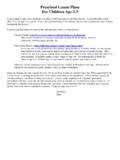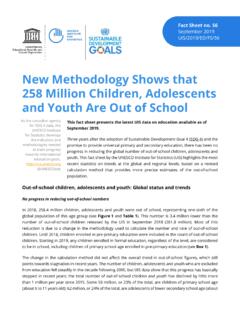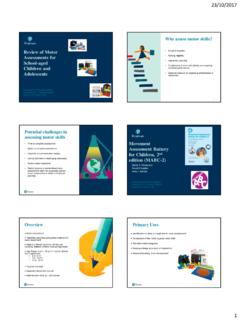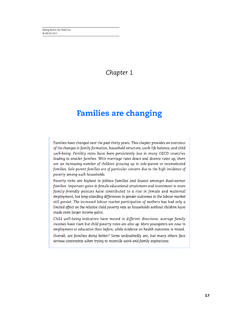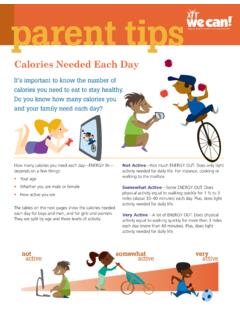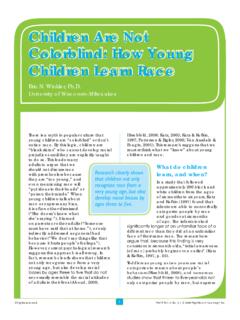Children 2
Found 10 free book(s)Developmental Assessment of Young Children 2 Edition
ucpalabama.org• The DAYC-2 is a comprehensive tool for infants and young children. The 2nd Edition was published in October 2012. • Developed by Judith K. Voress, PhD and Taddy Maddox, PhD • Norm-Referenced / Provides Standard Scores • Cost is approximately $350 dollars for the initial kit with 25 scoring sheets for each domain. Additional scoring sheets
CHCECE011 Provide experiences to support children’s play ...
aspire-solidus-production.s3-ap-southeast-2.amazonaws.comTopic 2 Supporting children’s play and learning . 35 2A Engaging in play 37. 2B Meeting play needs 43 2C Offering play choices 46. Summary 49. Learning checkpoint 2: Supporting children’s play and learning 50. Topic 3 Facilitating children’s play, learning and physical activity . 51 3A Participating in play 53. 3B Responding to children 58
Estimated Prevalence of Children With Diagnosed ...
www.cdc.govChildren aged 8–12 years (2.88%) were more likely to have been diagnosed with autism spectrum disorder than children aged 3–7 years (2.23%). Figure 2. Prevalence of children aged 3–17 years ever diagnosed with autism spectrum disorder, by sex, age, and race and ethnicity: United States, 2014–2016 Percent 0 123 4 Non-Hispanic other Girls ...
Preschool Lesson Plans For Children Age 2-3
pammshouse.comchildren age 4-5, children age 2-3 can benefit from the games and songs as well. There are various worksheet sites I have listed on my Toddler & Preschool Fun Page. Refer to these whenever you would like letter, number, color, or shape worksheets. These are lessons are only a guide for you. Do as much or as little as you have time for.
New Methodology Shows that 258 Million Children ...
uis.unesco.orgstopped in recent years; the total number of out-of-school children and youth has declined by little more than 1 million per year since 2015. Some 59 million, or 23% of the total, are children of primary school age (about 6 to 11 years old); 62 million, or 2 4% of the total, are adolescents of lower secondary school age (about
Movement Assessment Battery for Children, 2nd edition …
www.pearsonclinical.com.aufor Children, 2nd edition (MABC-2) • Presented by Amy Schulenburg • Consultant OT - Pearson Clinical Assessment (Aust & NZ) Sheila E Henderson David A Sugden Anna L Barnett Overview • •Motor assessment • “Identifies, describes and guides treatment of motor impairment” • Subtests: Manual Dexterity, Aiming and
Families are changing - OECD
www.oecd.orgthe past few decades, falling from an average of 2.7 children per woman in 1970 to just over 1.7 in 2009 (Figure 1.2, Panel A). The average TFR across the OECD bottomed out at 1.6 children per woman in 2002 and has since edged up. Overall, the average TFR across the OECD has been below replacement level since 1982.3 In 2009, the TFR was around the
Parent Tips: Calories Needed Each Day
www.nhlbi.nih.gov• For children, more calories are needed at older ages. • For adults, fewer calories are needed at older ages. Calories Needed Each Day for Boys and Men . Age Not Active . Somewhat Active Very Active ; 2–3 years 1,000–1,200 calories ; 1,000–1,400 calories 1,000–1,400 calories :
Suicidal Behavior in Children and Adolescents
www.apa.org2.4% made a suicide attempt that resulted in an injury, poisoning, or an overdose that required medical attention . Risk and Protective Factors ... For …
Children Are Not Coloblind: How Young Children Learn Race
inclusions.orgchildren’s environments, and in our society as a whole, teach children that race is a social category of significance. Bigler and her colleagues found that environments teach young children which categories seem to be most important (Bigler & Liben, 2007; Patterson & Bigler, 2006). Children then attach meaning to those social categories



